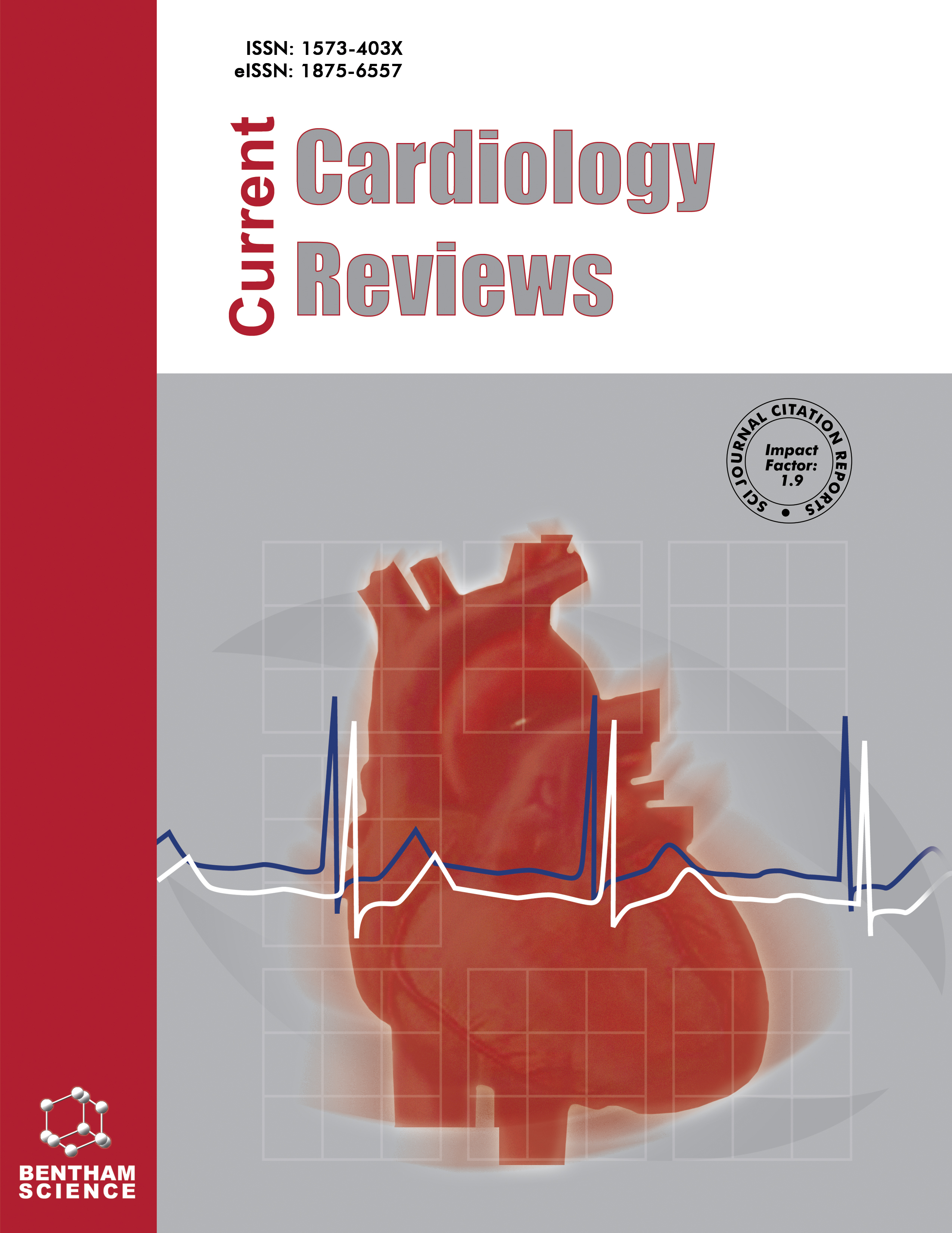- Home
- A-Z Publications
- Current Cardiology Reviews
- Previous Issues
- Volume 2, Issue 1, 2006
Current Cardiology Reviews - Volume 2, Issue 1, 2006
Volume 2, Issue 1, 2006
-
-
Atherosclerotic Plaque Detection by Multi-detector Computed Tomography
More LessAuthors: Javed Butler and Udo HoffmannCoronary artery disease (CAD) remains a leading cause of death worldwide. In order to reduce the mortality from CAD, early detection and intervention prior to adverse events is likely to yield the most benefit. This however necessitates reliable prediction of high-risk patients. The current prediction schemes that incorporate traditional risk factors like hypertension and dyslipidemia are not very sensitive and improvements i Read More
-
-
-
Management of Acute Coronary Syndromes in Patients with Renal Insufficiency
More LessAuthors: Giancarlo Marenzi, Emilio Assanelli and Antonio L. BartorelliChronic kidney disease (CKD) is highly prevalent in patients with acute coronary syndromes (ACS) and is associated with poor outcomes. The clinical management of patients with CKD who develop ACS is problematic because of the lack of well-designed randomized trials assessing therapeutic strategies in such patients. The almost uniform exclusion of patients with CKD from randomized studies evaluating new targeted therapi Read More
-
-
-
Real-Time 3D Echocardiography: A New Gold Standard for Rheumatic Mitral Stenosis Assessment
More LessAuthors: Jose Zamorano and Leopoldo P. de IslaReal-Time 3D echocardiography allows us to visualize every cardiac structure in any desired plane orientation, including the mitral valve. In this article we describe the recent advances in the assessment of the mitral valvular area and mitral valve anatomy by means of the use of Real-Time 3D echocardiography. Real-Time 3D echocardiography has been shown as a useful tool to evaluate those patients with rheumatic mitral Read More
-
-
-
Mitral Balloon Valvuloplasty: State-of-the-Art Paper
More LessPercutaneous mitral balloon valvuloplasty (MBV) was introduced in 1984 by Inoue who developed the procedure as a logical extension of surgical closed commissurotomy. Since then, MBV has emerged as the treatment of choice for severe pliable rheumatic mitral stenosis (MS). With increasing experience and better selection of patient, the immediate results of the procedure have improved and the rate of complicati Read More
-
-
-
Percutaneous Valve Interventions
More LessPercutaneous valve interventions is a rapidly evolving field of cardiovascular therapy. New technologies for aortic valve replacement and mitral valve repair are now developing in addition to the well established techniques of balloon valvuloplasty for the treatment of mitral and aortic stenosis. A number of devices are under development and investigation, and are going to be used in humans in the next few years to tr Read More
-
-
-
Minimally Invasive and Noninvasive Hemodynamic Monitoring of the Cardiovascular System: Available Options and Future Perspectives
More LessMonitoring of Cardiac Output (CO) is of paramount importance in the critical patient. Established methods used to measure CO, such as oxygen Fick approach and thermodilution, are invasive and do not allow continuous monitoring. In addition, they are not reliable in the hemodynamically instable patient and suffer several technical drawbacks. Alternative methods are available, such as the Pulse Contour Method, but are d Read More
-
-
-
The Fetal Cardiac Function
More LessAuthors: Ganesh Acharya, Juha Rasanen, Torvid Kiserud and James C. HuhtaDespite significant progress in the prenatal diagnosis of congenital heart disease and the postnatal management, the prenatal evaluation of fetal heart function remains difficult. The unique characteristics of the fetal circulation have a significant impact on its cardiac function. Commonly used physiological concepts about the function of the heart can be misleading when applied to the intrauterine situation. Most noninvasive pa Read More
-
-
-
Modeling Cardiovascular Development: New Approaches are Making In Vitro En Vogue
More LessAuthors: Richard L. Goodwin, Michael J. Yost and Jay D. PottsIn vitro models have proven themselves to be powerful allies with in vivo models for the dissection of the molecular mechanisms of cardiovascular development. The purpose of this manuscript is to review the advances that have enabled the creation of a new generation of in vitro models. These advances include the advent of new biomaterials and cell scaffolds that have provided the opportunity to design niches where de Read More
-
-
-
The Secondary Heart Field: Understanding Conotruncal Defects from a Developmental Perspective
More LessAuthors: Cary Ward and Margaret KirbyThe development of a septated outflow is complicated, and insight into this process has been limited. However, our lab and others have recently described a secondary source of myocardium that adds to the lengthening outflow tract at later stages of development. Without the addition of this secondary heart field (SHF), the outflow is shortened and can not undergo the rotation necessary to make appropriate ventriculoarterial Read More
-
-
-
Recent Advances in Small Animal Cardiac Magnetic Resonance Imaging
More LessAuthors: Matthias Nahrendorf and Wolfgang R. BauerSmall animal models of heart failure have added invaluable information to advance diagnosis, pathophysiology and treatment of patients with heart failure, a growing epidemic in the western world. During the last decade, advances in small animal magnetic resonance imaging have contributed to this accumulating body of knowledge. In the review we give an overview about imaging techniques, their application to heart failure Read More
-
Volumes & issues
-
Volume 21 (2025)
-
Volume 20 (2024)
-
Volume 19 (2023)
-
Volume 18 (2022)
-
Volume 17 (2021)
-
Volume 16 (2020)
-
Volume 15 (2019)
-
Volume 14 (2018)
-
Volume 13 (2017)
-
Volume 12 (2016)
-
Volume 11 (2015)
-
Volume 10 (2014)
-
Volume 9 (2013)
-
Volume 8 (2012)
-
Volume 7 (2011)
-
Volume 6 (2010)
-
Volume 5 (2009)
-
Volume 4 (2008)
-
Volume 3 (2007)
-
Volume 2 (2006)
-
Volume 1 (2005)
Most Read This Month
Article
content/journals/ccr
Journal
10
5
false
en


